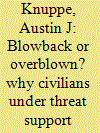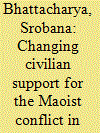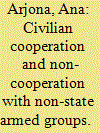| Srl | Item |
| 1 |
ID:
186861


|
|
|
|
|
| Summary/Abstract |
How do military tactics shape civilian support for foreign intervention? Critics contend that invasive tactics undermine popular support by alienating the civilian population. Counterexamples suggest that civilians will support invasive tactics when foreign counterinsurgents are willing and able to mitigate a proximate threat. I reconcile these divergent findings by arguing that civilian support is a function of threat perception based on three interacting heuristics: social identity, combatant targeting, and territorial control. To evaluate my theory, I enumerate a survey among Iraqi residents in Baghdad during the anti-ISIS campaign. Respondents preferred more invasive tactics when foreign counterinsurgents assisted the most effective local members of the anti-ISIS coalition. Across sectarian divides, however, respondents uniformly opposed the deployment of foreign troops. These findings suggest that in regime-controlled communities, civilians will support counterinsurgents who are invasive enough to mitigate insurgent threats, but not too invasive as to undermine local autonomy.
|
|
|
|
|
|
|
|
|
|
|
|
|
|
|
|
| 2 |
ID:
128563


|
|
|
|
|
| Publication |
2013.
|
| Summary/Abstract |
Prolonged domestic political conflicts change over time. The Maoist conflict in India which began in the late 1960s is one such conflict. Over time, the 'old' Maoist conflict has become a 'new' Maoist conflict. Important changes have occurred both in the macro and micro processes of the conflict. Some of these changes include the strategic relocation of the Maoist bases, a shift in the class character of the conflict, the nature of civilian support, and the rebels' methods of operation. While in the 1960s, the conflict was involved in land redistribution with the aim of annihilating class enemies, the recent conflict focuses on caste identities. In addition, it is intrinsically linked with territorial control and local political competition. This has automatically led the Maoists to become involved with local criminal networks and also local business networks based. This involvement has led to financial resources for the conflict. Furthermore, it has forced the local population to become linked with the conflict. Studying these changes is important, especially for counterinsurgency policies.
|
|
|
|
|
|
|
|
|
|
|
|
|
|
|
|
| 3 |
ID:
153613


|
|
|
|
|
| Summary/Abstract |
Terms like ‘support’ and ‘collaboration’ are often used interchangeably to denote a loose set of acts or attitudes that benefit non-state armed groups (NSAGs). However, these terms are seldom defined, and the alternatives available to civilians are rarely identified. Moreover, existing approaches overlook that the interaction between civilians and NSAGs is often one between ruler and ruled, which makes obedience and resistance central. This paper proposes to conceptualize the choices available to civilians as forms of cooperation and non-cooperation, offers a typology, and discusses the implications for theory building on civilian and NSAG behavior, and on the functioning of armed social orders.
|
|
|
|
|
|
|
|
|
|
|
|
|
|
|
|